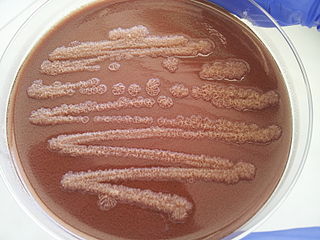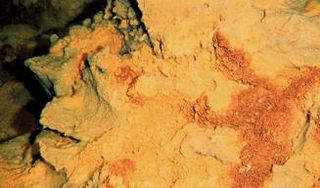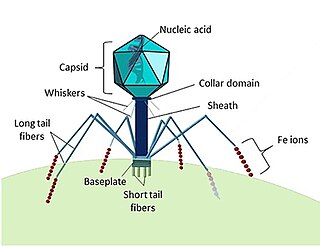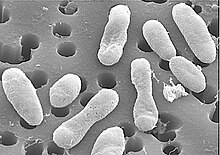
Alphaproteobacteria is a class of bacteria in the phylum Pseudomonadota. The Magnetococcales and Mariprofundales are considered basal or sister to the Alphaproteobacteria. The Alphaproteobacteria are highly diverse and possess few commonalities, but nevertheless share a common ancestor. Like all Proteobacteria, its members are gram-negative, although some of its intracellular parasitic members lack peptidoglycan and are consequently gram variable.
Pseudomonas citronellolis is a Gram-negative, bacillus bacterium that is used to study the mechanisms of pyruvate carboxylase. It was first isolated from forest soil, under pine trees, in northern Virginia, United States.

Pseudomonas stutzeri is a Gram-negative soil bacterium that is motile, has a single polar flagellum, and is classified as bacillus, or rod-shaped. While this bacterium was first isolated from human spinal fluid, it has since been found in many different environments due to its various characteristics and metabolic capabilities. P. stutzeri is an opportunistic pathogen in clinical settings, although infections are rare. Based on 16S rRNA analysis, this bacterium has been placed in the P. stutzeri group, to which it lends its name.

The class Zetaproteobacteria is the sixth and most recently described class of the Pseudomonadota. Zetaproteobacteria can also refer to the group of organisms assigned to this class. The Zetaproteobacteria were originally represented by a single described species, Mariprofundus ferrooxydans, which is an iron-oxidizing neutrophilic chemolithoautotroph originally isolated from Kamaʻehuakanaloa Seamount in 1996 (post-eruption). Molecular cloning techniques focusing on the small subunit ribosomal RNA gene have also been used to identify a more diverse majority of the Zetaproteobacteria that have as yet been unculturable.
Alteromonas macleodii is a species of widespread marine bacterium found in surface waters across temperate and tropical regions. First discovered in a survey of aerobic bacteria in 1972, A. macleodii has since been placed within the phylum Pseudomonadota and is recognised as a prominent component of surface waters between 0 and 50 metres. Alteromonas macleodii has a single circular DNA chromosome of 4.6 million base pairs. Variable regions in the genome of A. macleodii confer functional diversity to closely related strains and facilitate different lifestyles and strategies. Certain A. macleodii strains are currently being explored for their industrial uses, including in cosmetics, bioethanol production and rare earth mining.
Roseobacter litoralis is a species of aerobic pink-pigmented bacteria. It contains Bacteriochlorophyll a. It contains spheroidenone, does not synthesize bacteriochlorophyll anaerobically, but shows aerobic phototrophic activity. It is also considered a photosynthetic marine bacterium. Cells are ovoid or rod-shaped and motile by subpolar flagella. R. litoralis does not reduce nitrate, while R. dentrificans does. R. litoralis can be found in marine seaweed.
Roseobacter denitrificans is a species of aerobic pink-pigmented bacteria. It contains Bacteriochlorophyll a. It contains spheroidenone, does not synthesize bacteriochlorophyll anaerobically, but shows aerobic phototrophic activity. Cells are ovoid or rod-shaped and motile by subpolar flagella. R. litoralis does not reduce nitrate, while R. denitrificans does.
Desulfitobacterium dehalogenans is a species of bacteria. They are facultative organohalide respiring bacteria capable of reductively dechlorinating chlorophenolic compounds and tetrachloroethene. They are anaerobic, motile, Gram-positive and rod-shaped bacteria capable of utilizing a wide range of electron donors and acceptors. The type strain JW/IU-DCT, DSM 9161, NCBi taxonomy ID 756499.
Desulfitobacterium hafniense is a species of gram positive bacteria, its type strain is DCB-2T..
Ruegeria pomeroyi is a species of Gram-negative, rod-shaped, aerobic dimethylsulfoniopropionate-demethylating bacterium. Its type strain is DSS-3T. Its genome has been sequenced.

Salinispora is a genus of obligately aerobic, gram-positive, non-acid-fast bacteria belonging to the family of Micromonosporaceae. They are heterotrophic, non-motile, and obligately grow under high osmotic/ionic-strength conditions. They are the first identified genus of gram-positive bacteria which has a high osmotic/ionic-strength requirement for survival. They are widely abundant in tropical marine sediments and were first identified in 2002. This genus of bacteria has potential biotechnological significance due to their production of novel secondary metabolites which can be used pharmaceutically.
Congregibacter litoralis KT71 is a gram-negative Gammaproteobacteria part of the NOR5/OM60 Clade discovered in seawater from Heligoland, an island in the North Sea by H. Eilers from the Max Planck Institute for Microbiology. C. litoralis KT71 is described as a pleomorphic bacterium and has a size of 2 x 0.5 μm. When grown in culture, C. litoralis KT71 has a generation time of 4.5 hours and prefers to grow on complex substrates where the sole carbon source is undefined, though it can utilize some sole carbon sources because they are most likely used by the organism for its central metabolism.
Mary Ann Moran is a distinguished research professor of marine sciences at the University of Georgia in Athens. She studies the role of bacteria in Earth's marine nutrient cycles, and is a leader in the fields of marine sciences and biogeochemistry. Her work is focused on how microbes interact with dissolved organic matter and the impact of microbial diversity on the global carbon and sulfur cycles. By defining the roles of diverse bacteria in the carbon and sulfur cycles, she connects the biogeochemical and organismal approaches in marine science.
Polaribacter is a genus in the family Flavobacteriaceae. They are gram-negative, aerobic bacteria that can be heterotrophic, psychrophilic or mesophilic. Most species are non-motile and species range from ovoid to rod-shaped. Polaribacter forms yellow- to orange-pigmented colonies. They have been mostly adapted to cool marine ecosystems, and their optimal growth range is at a temperature between 10 and 32 °C and at a pH of 7.0 to 8.0. They are oxidase and catalase-positive and are able to grow using carbohydrates, amino acids, and organic acids.
Dinoroseobacter shibae is a facultative anaerobic anoxygenic photoheterotroph belonging to the family, Rhodobacteraceae. First isolated from washed cultivated dinoflagellates, they have been reported to have mutualistic as well as pathogenic symbioses with dinoflagellates.
Methylophaga thiooxydans is a methylotrophic bacterium that requires high salt concentrations for growth. It was originally isolated from a culture of the algae Emiliania huxleyi, where it grows by breaking down dimethylsulfoniopropionate from E. hexleyi into dimethylsulfide and acrylate. M. thiooxydans has been implicated as a dominant organism in phytoplankton blooms, where it consumes dimethylsulfide, methanol and methyl bromide released by dying phytoplankton. It was also identified as one of the dominant organisms present in the plume following the Deepwater Horizon oil spill, and was identified as a major player in the breakdown of methanol in coastal surface water in the English channel.

Marine viruses are defined by their habitat as viruses that are found in marine environments, that is, in the saltwater of seas or oceans or the brackish water of coastal estuaries. Viruses are small infectious agents that can only replicate inside the living cells of a host organism, because they need the replication machinery of the host to do so. They can infect all types of life forms, from animals and plants to microorganisms, including bacteria and archaea.
Lone Gram is Danish microbiologist known for her work in bacterial physiology, microbial communication, and biochemicals that originate from bacterial cultures. She is an elected member of the Royal Danish Academy of Sciences and Letters and has received the Order of the Dannebrog.
Chromids, formerly secondary chromosomes, are a class of bacterial replicons. These replicons are called "chromids" because they have characteristic features of both chromosomes and plasmids. Early on, it was thought that all core genes could be found on the main chromosome of the bacteria. However, in 1989 a replicon was discovered containing core genes outside of the main chromosome. These core genes make the chromid indispensable to the organism. Chromids are large replicons, although not as large as the main chromosome. However, chromids are almost always larger than a plasmid. Chromids also share many genomic signatures of the chromosome, including their GC-content and their codon usage bias. On the other hand, chromids do not share the replication systems of chromosomes. Instead, they use the replication system of plasmids. Chromids are present in 10% of bacteria species sequenced by 2009.
Alison Buchan is the Carolyn Fite Professor at the University of Tennessee. She is known for her work on bacteria in natural environments, especially bacteria within the Roseobacter group. In 2022 she was named as a fellow of the American Academy of Microbiology.





